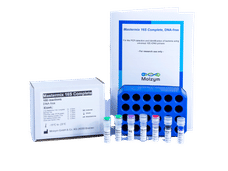Going Live With Click Chemistry: Berkeley Researchers Create a Copper-free Version of the Technique
Click chemistry, one of the most exciting and proficient new techniques for labeling biomolecules in vitro, has now been extended to studies in the context of live cells as well. This breakthrough opens the door for applications to live cell imaging of numerous biomolecules, including glycans, proteins and lipids. The new version of click chemistry was developed by researchers with the Lawrence Berkeley National Laboratory (Berkeley Lab) and the University of California (UC) at Berkeley. "We've developed a copper-free variant of the click chemistry reaction that possesses comparable kinetics to the copper-catalyzed reaction and proceeds within minutes on live cells with no apparent toxicity," said chemist Carolyn Bertozzi, the principal investigator on this project. "This is the first example of a click chemistry reaction that, like the copper-catalyzed version, proceeds at physiologically acceptable temperatures only without the toxic presence of copper."
Bertozzi is the director of Berkeley Lab's Molecular Foundry, a faculty scientist with Berkeley Lab's Materials Sciences and Physical Biosciences Divisions, the T.Z. and Irmgard Chu Distinguished Professor of Chemistry, and a professor of Molecular and Cell Biology at UC Berkeley. She is also an investigator with the Howard Hughes Medical Institute (HHMI), and a leading authority on glycobiology.
"We are already using our copper-free click chemistry technique to probe glycan dynamics in living cells and in live zebrafish embryos, which serve as a standard model of developmental biology," she said.
Bertozzi is the lead author on a paper published in the Proceedings of the National Academy of Sciences (PNAS) entitled: "Copper-free Click Chemistry for Dynamic In Vivo Imaging." Co-authoring this PNAS paper were Jeremy Baskin, Jennifer Prescher, Scott Laughlin, Nicholas Agard, Pamela Chang, Isaac Miller, Anderson Lo and Julian Codelli.
Click chemistry is the popular term for a copper-catalyzed azide-alkyne reaction that makes it possible for certain chemical building blocks to "click" together in an irreversible linkage. Since its introduction in 2001 by the Nobel laureate chemist Karl Barry Sharpless of the Scripps Research Institute, the copper-catalyzed azide-alkyne reaction has proven extremely valuable for attaching small molecular probes to various biomolecules in a test tube or on fixed cells. However, its use for biomolecule labeling in live cells or organisms is prohibited by the requirement of a cyotoxic copper catalyst.
For the past several years, Bertozzi has been developing new techniques for studying glycans. Even though glycans are ubiquitous on the surfaces of most cells and play a critical role in intercellular communications, methods for studying them have lagged behind other biomolecules.
"Glycans mediate a variety of cell surface recognition events such as bacterial and viral binding to host cells and leukocyte adhesion during an inflammatory response," said Bertozzi. "In addition to their cell surface roles, glycans can regulate many intracellular processes, including trafficking of proteins to the lysosome and transcription and translation."
There is great scientific interest in monitoring the dynamics of glycans as they move about within cells and on the cell surface, but the means to tag glycans with imaging probes has been lacking, thereby prohibiting such studies. Bertozzi and her coworkers had previously shown that glycans can be metabolically labeled with azides, permitting their chemical tagging with imaging probes through click chemistry, but the cytotoxicity of the click reaction would not allow dynamic imaging of live cells. To apply click chemistry to glycans, Bertozzi and her colleagues designed a new reagent called difluorinated cyclooctyne or DIFO, that reacts with azides rapidly at physiological temperatures without the need for a toxic catalyst.
"Our critical reagent, a substituted cyclooctyne, possesses ring strain and electron-withdrawing fluorine substituents that together promote the cycloaddition with azides installed metabolically into biomolecules," said Bertozzi. "This copper-free click reaction of azides and DIFO combines the biocompatibility of the Staudinger ligation [a highly successful labeling reaction previously developed in Bertozzi's lab] with the fast reaction kinetics of click chemistry."
Bertozzi says their copper-free click chemistry technique can be used to probe any biomolecule that can be labeled with an azide, including glycans, proteins and lipids. She and her group are now using this technique to study glycan trafficking - how glycans and their associated scaffolds move around inside cells and on cell surfaces. They have made their DIFO reagents available to other research groups and are in discussions with potential commercial suppliers to make the reagents widely available to the bio research community.
"Direct imaging of glycan trafficking under conditions of cell stimulation or pharmacological intervention can be performed in cells, tissues, or even whole organisms," said Bertozzi. "More broadly, other metabolites, post-translational modifications, enzyme activities, and site-specific labeled proteins can be monitored in real time and in living systems with our copper-free click chemistry.".
Other news from the department science
These products might interest you
Most read news
More news from our other portals
See the theme worlds for related content
Topic World Cell Analysis
Cell analyse advanced method allows us to explore and understand cells in their many facets. From single cell analysis to flow cytometry and imaging technology, cell analysis provides us with valuable insights into the structure, function and interaction of cells. Whether in medicine, biological research or pharmacology, cell analysis is revolutionizing our understanding of disease, development and treatment options.

Topic World Cell Analysis
Cell analyse advanced method allows us to explore and understand cells in their many facets. From single cell analysis to flow cytometry and imaging technology, cell analysis provides us with valuable insights into the structure, function and interaction of cells. Whether in medicine, biological research or pharmacology, cell analysis is revolutionizing our understanding of disease, development and treatment options.





























































